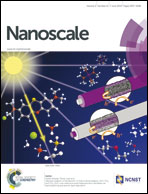Radiofrequency treatment enhances the catalytic function of an immobilized nanobiohybrid catalyst†
Abstract
Biocatalysis, the use of enzymes in chemical transformation, has undergone intensive development for a wide range of applications. As such, maximizing the functionality of enzymes for biocatalysis is a major priority to enable industrial use. To date, many innovative technologies have been developed to address the future demand of enzymes for these purposes, but maximizing the catalytic activity of enzymes remains a challenge. In this study, we demonstrated that the functionality of a nanobiocatalyst could be enhanced by combining immobilization and radiofrequency (RF) treatment. Aminopeptidase PepA-encapsulating 2 nm platinum nanoparticles (PepA–PtNPs) with the catalytic activities of hydrolysis and hydrogenation were employed as multifunctional nanobiocatalysts. Immobilizing the nanobiocatalysts in a hydrogel using metal chelation significantly enhanced their functionalities, including catalytic power, thermal-stability, pH tolerance, organic solvent tolerance, and reusability. Most importantly, RF treatment of the hydrogel-immobilized PepA–PtNPs increased their catalytic power by 2.5 fold greater than the immobilized PepA. Our findings indicate that the catalytic activities and functionalities of PepA–PtNPs are greatly enhanced by the combination of hydrogel-immobilization and RF treatment. Based on our findings, we propose that RF treatment of nanobiohybrid catalysts immobilized on the bulk hydrogel represents a new strategy for achieving efficient biocatalysis.


 Please wait while we load your content...
Please wait while we load your content...